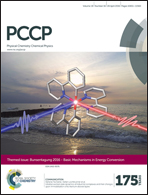The electronic transport properties of zigzag silicene nanoribbon slices with edge hydrogenation and oxidation†
Abstract
First principles calculations are performed to study the transport properties of H or H2 edge-hydrogenated zigzag silicene nanoribbon slices with 6 zigzag chains (6ZSiNR) as well as OH or O edge-oxidized 6ZSiNR slices connected with H-terminated 6ZSiNR electrodes. We mainly focus on two configurations: symmetric edge modification and asymmetric edge modification. It is found that these configurations show distinctly different transport behaviours under bias voltages, depending on whether their structures satisfy c2 symmetry operation along the central axis. In addition, the effects of various functional groups on the electronic transport are investigated; comparison of the current magnitudes indicates that the H group has the strongest effect, followed by the OH group, the O group, and the H2 group. This difference is revealed to be related to the coupling interaction between the edge groups of the ZSiNR slices and the H groups of the ZSiNRs electrodes, as well as the transmission channels around the Fermi level.


 Please wait while we load your content...
Please wait while we load your content...